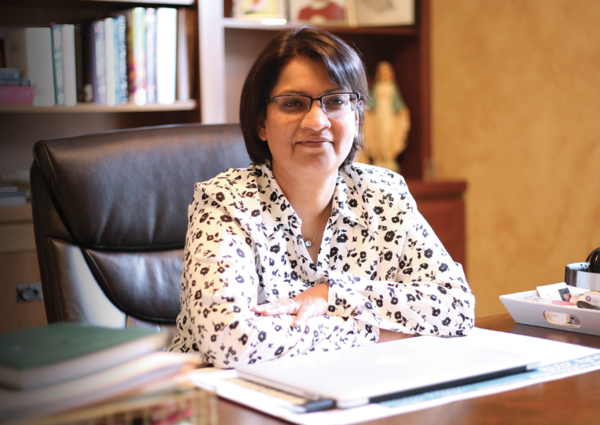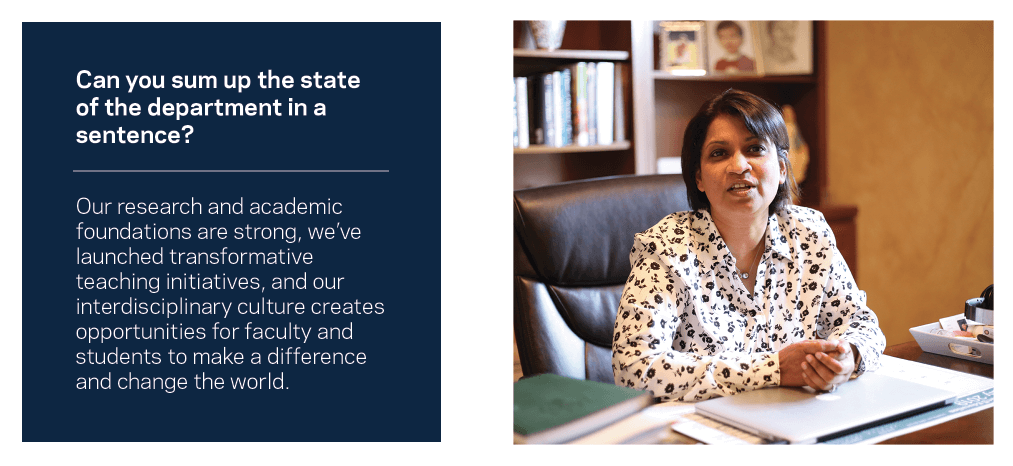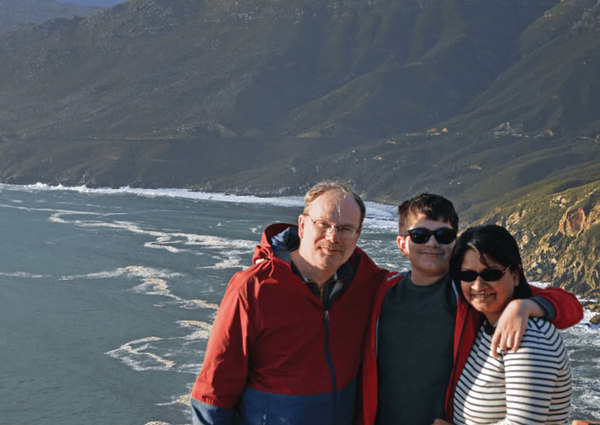
Crislyn D’Souza-Schorey is Professor and Chair of the Department of Biological Sciences. She is the first woman to serve in the role. In addition to oversight of a department of over 80 faculty and one of the largest undergraduate majors and graduate programs on campus, she also runs her cancer research laboratory. She is married to Jeffrey Schorey, Professor of Biological Sciences; they have a son, who will be a freshman in high school in the fall. D'Souza-Schorey is also a member of the Eck Institute for Global Health.
What have you found appealing in your role as chair?
The department is the core of the life sciences at Notre Dame. We have a terrific faculty, many with extraordinary accomplishments. They brainstormed to strategically plan the growth and expansion of the department. And it’s been opportune time to implement innovations in teaching. Our collective strategic goals have allowed us to further excellence in our laboratories, promote creative expression in our classrooms and make a difference in the community. It’s fulfilling to chart a path that seems to impact many.
What makes being a biologist at Notre Dame special?
The size and breadth of our programs allow not just disciplinary efforts but also cross-disciplinary interactions. We are positioned to be more than the sum of our individual parts. That’s exciting. Our efforts lend seamlessly toward societal good and are in keeping with the mission of the University. We also have a superb student body. At every commencement, I find myself in awe of, and energized by, the vast and varied accomplishments of our seniors.
You’ve been on the faculty for a while. Do you feel any differently as the department chair?
I have a lot more responsibility as chair. And with it comes increased accountability. Purpose matters. It’s humbling. But I’ve also got great teams, both faculty and staff, to assist me. In this role, success is linked to and determined by those you serve and work with.
What is your teaching philosophy from undergraduates to postdoctoral researchers?
Learning is a life long process. The classroom should encourage creative thinking, inclusivity and be a safe place to learn. Years after a student graduates, he or she may not remember the specifics, but if they can think through a problem—the why and the how—then as science professors, we’ve done our job. As for my graduate students and postdocs, I encourage them to ask exciting questions that challenge them. It takes a high level of discipline to keep one’s self on task. My role is to guide the process and ensure that they reach their full potential of experimental creativity and rigor.
Is there a department project you are particularly excited about?
Introductory Biology. We have revamped our introductory biology classes, and we’ve done so largely because of the changing science education landscape. The major focus of the biological sciences —understanding life—remains unchanged, but breakthrough discoveries of the 20th century have changed the nature of the questions asked, while new technologies are changing the ways key questions are addressed. As a result, what we should teach, and how, has evolved and this forms the basis of Vision and Change in Biology Education, spearheaded by the AAAS. It emphasizes the importance of scientific competencies, and also, inclusive excellence in the classroom, i.e. reaching all students—with diverse backgrounds, skills and preparedness. Since students learn science best by doing science, our remodeled introductory teaching labs allow every undergraduate student an original research experience. I am proud of, and grateful to, the faculty who were responsible for enabling the revamping of these courses, which required thoughtful deliberation and execution. My colleagues have described this undertaking as transformative to our curriculum and department. I concur.
I am also enthusiastic about more recent ongoing efforts to further the global profile and engagement of our graduate program. I see it as crucial to advancing our mission of excellence in discovery and learning in the present day.
What is your approach to growing the research enterprise?
Our approach has been to build strategically and programmatically around particular thematic areas—areas of strength, or areas that are trending in the life sciences that we‘d like to develop. We are excited to invest in those unique individuals who bridge traditional disciplinary strengths and have made some terrific hires in this regard. But as with any bridge, if the pillars aren’t strong, it can fall apart. Balance is important. It paves the way for strategic and strong partnerships, both internal and external.
Can you tell us about your own research and what aspects of it you are excited about?
My research program places at the intersection of two tremendously exciting areas of biomedical research—Cell Biology and Molecular Oncology. I am a cell biologist keenly interested in understanding the mechanisms that underlie tumor progression. We focus on deciphering how tumor cells acquire the invasive phenotype—i.e. the ability to break away from its primary site and infiltrate the surroundings. Non-cancerous cells are not nearly as mobile. We dissect these processes in molecular detail. Some of our work has considerable translational potential. For example, we study extracellular vesicles, which are small sacs shed by tumor cells into body fluids. We were one of the first labs to describe a subset of these sacs that may in fact serve as reporters of the state of the tumor. This could form the basis of a rather innovative diagnostic platform.
What one adjective would you use to describe your department?
Collaborative. Our faculty have research interests that span the breadth of the life sciences, across foci as varied as global health, cancer, organ regeneration, climate change and biodiversity. We have interdisciplinary collaborations within our department, across campus, and with universities worldwide, through life science-related investigation and problem solving. Several faculty lead or are involved in large program type endeavors. They get that they are part of something larger. An example is the recent grant from UNITAID to eradicate vector-borne disease, the core of which involves 5 of our faculty but with strategic partners across campus and other organizations across the globe. Embarking on such projects requires a collaborative spirit.
What if you had another adjective?
Dedicated. We have had our share of let downs and disappointment and experienced loss in more ways than one. Yet in the past year we have surpassed our best record yet of research funding alongside a very strong showing of research productivity, and further, we launched one of the most transformative changes to our curriculum. I think it’s because for the most part we have a resilient and dedicated faculty who focus on the mission at hand and less on differences or challenges. And when you do that, there is no challenge too great.
What is your philosophy on faculty hiring and promotion?
Hire the best. Retain the best. With faculty recruiting we have to ensure that we have applicant pools and short lists that are diverse. We have generated a set of recommended practices for faculty searches that fosters inclusive excellence and raises awareness about implicit bias. The inclusion of the full tenured faculty in our tenure promotions process has provided transparency and accountability in our evaluations at the department level. I’m also pleased that the faculty voted unanimously to change the department’s tenure clock, a move that was supported by the University’s administration. With the roughly 30 promotion and reappointment cases I’ve overseen as chair, I’ve appreciated even more the unique ways each and every junior colleague contributes to the fabric of our department.

Academia is still male-dominated. How do you handle it?
At many points in my career, I’ve been given opportunities. Some of my most impactful mentors, those who have made a difference, have been male. I will add that there are strong women role models in academia too. I admire and have learned from them even from afar. All of these experiences guide my approach to research, teaching and administration. If I have encountered situations that I consider inappropriate, I first question if my own perception is accurate, and if so, I do not hesitate to address the situation. Usually institutions have portals to address true breaches.
What advice do you have for young women faculty?
Don’t make assumptions, do your homework. Stay task-focused, follow through, try and find common ground whenever possible. Make time for your family and personal life.
How do you balance your professional and personal life?
My personal responsibilities and obligations as scientist and administrator are all essential elements of my current roles. Each day I prioritize and make choices about what is most important at any given time. My family has always been supportive and keeps me centered.
 D’Souza-Schorey enjoyed a vacation with her husband, Jeff Schorey (far left) and son, Jason, in South Africa, this summer.
D’Souza-Schorey enjoyed a vacation with her husband, Jeff Schorey (far left) and son, Jason, in South Africa, this summer.
Originally published by at biology.nd.edu on October 30, 2019.